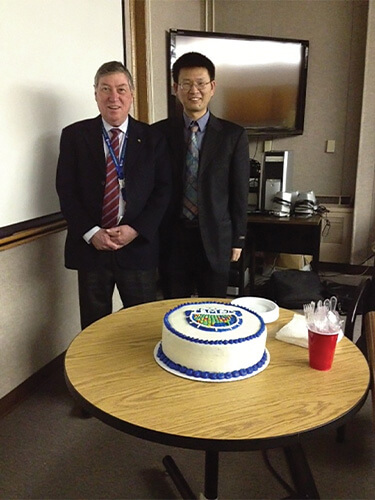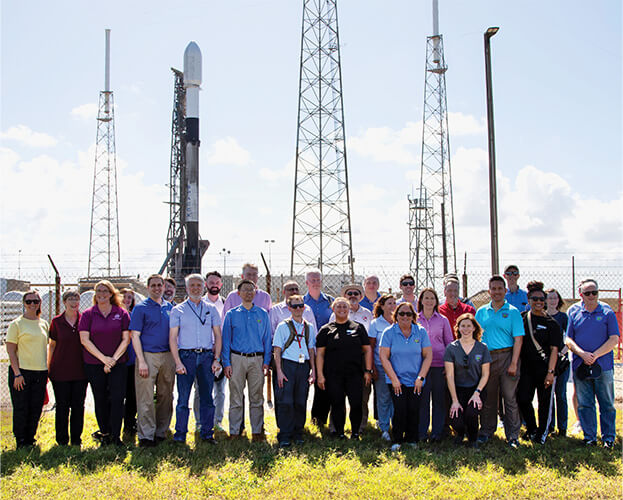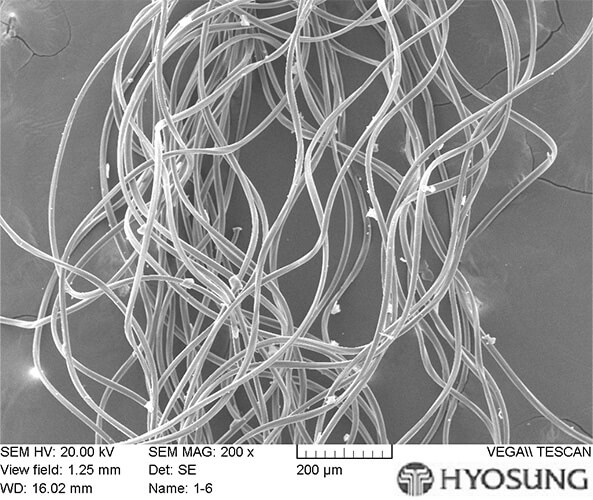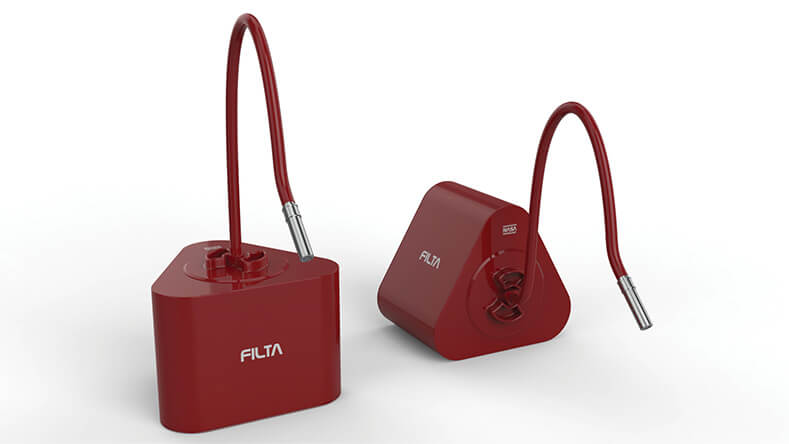Companies are drawing on NASA technologies that were originally designed for space application and adapting them to address the needs of a changing climate
When the Voyager 1 spacecraft was hurtling past Neptune to points beyond, its camera swung back to snap an image of Earth, a tiny spot of light in the vast, dark expanse. That 1990 image offered a stark reminder of just how vulnerable our planet is. The U.S. National Aeronautics and Space Administration (NASA) remains focused on space exploration today, but is also providing an Earth-side role, notably in understanding climate change and how it affects human health, and in inspiring new research and products to help people cope with varying weather patterns and the threats they bring.
In late March 2023, NASA released its agency climate strategy [1], which NASA administrator Bill Nelson called a “declaration of our continued commitment to lead on climate—and how we intend to do so” [2]. Key areas in the strategy include providing both sweeping and precise climate data, and encouraging innovation to cope with global warming and the collection of health hazards that it brings.
The innovation has already begun. Companies are drawing on NASA technologies that were originally designed for space application and adapting them to make products to keep people safe. This includes a company that is modifying spaceship reflective materials into clothing for use in high heat, and another that is using NASA-derived technology to develop water filters that can eliminate pathogens, notably those that become more numerous and widespread as temperatures rise.

Figure 1. Physicist researchers, Xiong Liu, Ph.D., and Kelly Chance, Ph.D., of the Smithsonian Astrophysical Observatory, Center for Astrophysics | Harvard and Smithsonian, celebrate the kickoff of the TEMPO mission at NASA Langley Research Center in February 2013. TEMPO is designed to take hourly measurements of air pollutants across of most of North America, which will provide a greater understanding of the health effects of climate change. Chance is PI of the TEMPO project, and Liu is deputy PI. (Photo courtesy of Xiong Liu.)
Climate data
The April 2023 launch of a satellite carrying the Tropospheric Emissions: Monitoring of Pollution (TEMPO) instrument is one of the ways NASA hopes to provide a clearer understanding of climate change and its impacts on human health (Figure 1). The instrument will measure pollutants in the troposphere, or the lower-most layer of the atmosphere where 99% of airborne pollutants reside, and do so hourly for the first time over the continental U.S. and also much of Canada and Mexico, as well as parts of the Caribbean. TEMPO will take measurements of such pollutants as ozone, aerosols, nitrogen dioxide, sulfur dioxide, and formaldehyde, and yield data with a spatial resolution of about 4 square miles.
“With those data, we can significantly improve our understanding of the chemical, dynamic, and physical processes, and understand the spatial/temporal variation of the air pollution,” remarked Xiong Liu, Ph.D., deputy principal investigator (PI) for the TEMPO mission, and physicist in the Smithsonian Astrophysical Observatory/Harvard College Observatory Center for Astrophysics (Figure 2). This highly detailed picture of North American pollution variability is especially vital because climate change is fueling health issues due to such things as windblown dust from droughts, smoke from wildfires, and increases in allergens due to longer warm periods.

Figure 2. Liu (in long-sleeved blue shirt) was part of the TEMPO team on hand in Cape Canaveral, FL, for the launch (inset) of the satellite-borne TEMPO instrument. A SpaceX Falcon 9 rocket (shown behind and to Liu’s right) carried the instrument into space, and TEMPO now sits in stationary orbit above the equator at 91° west longitude. (Photo courtesy of Xiong Liu.)
Liu referred to the American Lung Association’s 2023 State of the Air report [3], which noted that more than one-third of Americans live in places with unhealthy levels of air pollution, and another by the World Health Association (WHO) [4], which noted worldwide estimates of more than 4 million deaths per year associated with outdoor air pollution. “There’s a lot of studies that have shown links between air pollution and increased risk of chronic obstructive pulmonary disease, respiratory infections, asthma, lung cancer, preterm births, heart disease, stroke, and diabetes,” he said. By monitoring hourly and providing data down to 4 square miles, TEMPO will be able to pinpoint pollution hotspots, which often lie in urban areas where they inordinately affect people of color, he added. “So, TEMPO data may also, hopefully, lead to policy changes to mitigate this environmental injustice.”
The TEMPO instrument and its data products will be verified and optimized for several months with public release of those data products scheduled for April 2024, Liu said. NASA is also funding an Early Adopters Program designed to broaden and enhance the application of its air-quality data for health studies, he said. Early adopters include federal, state, and local air-quality agencies, health organizations, nonprofit organizations, and international partners who are planning a wide range of studies. “That program has been very successful with more than 400 early adopters, even before launch, who are attending workshops and training using proxy TEMPO data.”
Liu also expects that some of the upcoming studies will take into account similar climate data generated by other sources, such as South Korea’s Geostationary Environment Monitoring Spectrometer (GEMS) instrument, which launched in 2020; the European Space Agency’s Sentinel-4 to be launched in late 2024; existing low-Earth-orbit satellite instruments; and ground-based and airborne measuring instruments. Likewise, others will use TEMPO data to inform climate models. “By combining these satellite and other measurements, chemistry transport models (atmospheric-chemistry simulations), and air-quality forecast models, we will have a more complete picture that will enhance our understanding of these very complicated processes,” he remarked. Over time, he expects these data and related studies to track the effects of air pollution mitigation strategies, such as the evolution of vehicles from fossil fuels to electric-powered, so scientists can monitor how those strategies affect air pollution and impact health.
Warm-weather gear
The NASA technology that captured the attention of Trizar Technology of Moorestown, North Carolina, USA, was its heat-protective coating material and its potential application for clothing. “If your clothing isn’t smart, where your garment thermoregulates to the environment, you are going to be miserable, plus you’re not going to be able to do what you’re supposed to be doing,” said Brad Poorman (Figure 3), who along with Jim Hind is a co-founder of Trizar. The company has already adapted the NASA coating technology into fibers for consumer gear, and is now developing temperature-regulating clothing for outdoor workers who labor in today’s increasingly variable weather.

Figure 3. Brad Poorman is a co-founder of Trizar Technologies, which adapted NASA technology suited to today’s weather variation. Instead of insulating rockets from the scorching temperatures during re-entry to the atmosphere, the material eventually became fibers that generate temperature-regulating clothing well-suited to a climate-changed Earth. (Photo courtesy of Trizar Technologies.)
The coating dates back to the early 1990s when NASA developed it as a way to reflect heat from a rocket’s surface rather than absorbing it, a property known as low emissivity. It worked well, and in 1996, NASA licensed it to the company Emisshield of Blacksburg, VA, USA, which developed it into a heat-protective coating for industrial applications, such as kilns. Emisshield president and CEO John Olver eventually introduced Poorman and business partner Jim Hind, to the technology, and after seven years of trial and error, they got it to work in a textiles application.
“The key is when you’re putting particles into fibers that are about the size of a strand of hair,” Poorman said. “You can’t let those materials agglomerate or they stop the (manufacturing) process for cleaning, which is a big deal. And you cannot let too many of the particles get on the outside of the fiber, or it can be very abrasive.” The answer was just the right formulation and manufacturing technique and equipment, including some expensive extruders. The result is a patented mixture of particles that are designed to either increase or decrease emissivity, so to absorb or reflect heat (Figure 4).

Figure 4. NASA developed the heat-reflective material in the early 1990s. It was licensed to and adapted by another company as a heat-protective coating for industrial applications, and eventually was taken up by Trizar to make fibers (shown here) for clothing. Trizar now plans to produce temperature-regulating clothing that will keep outdoor workers cool during heat waves and warm and dry during cold snaps. (Photo courtesy of Trizar Technologies.)
To prove the concept, Trizar worked with a textile research institute in Taiwan that was able to measure infrared accumulation and emissivity, which demonstrated that their textiles functioned as intended. He noted that the data also allowed Emisshield to obtain patents in November 2020.
Besides the ability of the low-emissivity particles to reflect environmental heat and promote cooling, and its high-emissivity particles to promote warmth, both particles increase surface area of the textile and use energy from the wearer’s body to accelerate the evaporation of sweat, Poorman noted. This helps in summer and in winter: It keeps winter clothing dry even under a wearer’s exertion, which is key because wet clothing loses its insulative properties leaving the wearer chilled, sometimes dangerously so; and the evaporation keeps summer wearers cool, while maintaining the clothing’s ability to protect from the sun’s ultraviolet radiation. For the latter, he explained that an average cotton white shirt offering an ultraviolet protection factor (UPF) of 20 will drop to a UPF of 5 once it is wet. “What’s interesting about our fabrics is that when they get wet, the reflectivity increases so the UPF actually goes up,” he said.
Trizar has been collaborating with the large outdoor-workwear company Mark’s of Calgary, Canada, to create clothing for those workers who are particularly susceptible to weather swings associated with climate change, and the increasing health risks that go with them, he said. “The environment has changed so much, and yet the textile industry is still making fabrics and using equipment from the 1700s. I think people are starting to see that there are better, easier, faster and more economical ways of doing this. While we’re a very small company, we’ve been talking to some very large brands, so things are really starting to take off.”
Clean water for everyone
NASA technology also runs through the work of London, U.K., company nkd LIFE, which uses the material called NanoCeram, developed by Argonide Corp. of Sanford, FL, USA, and then optimized by NASA to sanitize recycled water in space. That material comprises nanofiber filters and microglass strands that become positively charged when water passes through them, and therefore entrap such impurities as bacteria, viruses, and parasites that are naturally negatively charged. With climate change, rising water temperatures, and increasing floods and droughts projected to exacerbate such contaminants [5], [6], [7], [8], the technology seemed an excellent candidate for water-filtration systems, said Piush Soni, co-founder of nkd LIFE (Figure 5).

Figure 5. Piush Soni is co-founder of nkd LIFE [6] of and OneFilta of London, U.K., which are incorporating NASA and other technologies into devices designed to filter impurities from water. Such technology will be increasingly important as climate change leads to increases in water-borne pathogens and other contaminants, the need for water-filtration systems will increase. (Photo courtesy of Piush Soni.)
OneFilta engineers restructured and rearranged the system while in the process of inventing new patented filtration technologies. The filtration system also incorporates media from team engineer Michael Pedersen, who had previously developed another NASA-inspired filtration material (AQUASPACE Compound) that uses highly porous carbonaceous materials to filter both organic and inorganic chemicals without undue clogging. They were successful. The filtration system provided the high level of bacteria and virus filtration to satisfy the WHO, it processed water quickly, and, as an added practical benefit, its particulate filter needed just a rinse to be cleaned and reused.
OneFilta already has produced a device that is about the size of a tea kettle, and a single device on a countertop can produce enough water for a family, Soni said (Figure 6). OneFilta is now scaling this technology to be able to satisfy a community. The devices are able to “reduce all of the hot buzzword contaminants, such as perfluorooctanoic acid and perfluorooctane sulfonate (PFOA and PFOS); do 5 log reductions for microbiological contaminants, and do heavy metals, which are an issue in certain parts of the United States,” he said, adding that the filter can be tailored to just about any contaminant of concern.

Figure 6. nkd LIFE has a personal water bottle on the market, and the OneFilta now has a countertop filtration system (shown here) to quickly filter bacteria, viruses, and other impurities from water. The company is gearing up to market individual countertop devices commercially, and also to scale this technology to put in schools and medical and community centers in developing countries. (Photo courtesy of OneFilta.)
The company is gearing up to market individual countertop devices commercially and scale this technology to put in schools and medical and community centers in developing countries, Soni said. “In fact, we are in the process of setting up our first major humanitarian project, and are looking to deploy 25,000 of these devices that will cater to 6.25 million people living in extreme water poverty, and do that deployment over a period of two months in the first quarter of 2024.”
To fund the humanitarian efforts, Soni plans to use the carbon credits that will result when local people no longer have to burn wood or kerosene to heat and purify water. Tracking credits will include a combination of the Internet of Things (IOT) device to send data to a Web3 platform enabled with blockchain technology for transparency. Beyond that, the company is preparing to launch an inflationary cryptocurrency backed by real world assets—the carbon credits—which will fuel the funding circle and ensure continued availability of clean water for those people who are most at risk, particularly in light of climate change. He added, “Our interest was originally on the humanitarian-aid side and it still is. That’s the priority goal.”
Looking to home
Just as Voyager 1 captured the 1990 photo of Earth while heading to the unknown, NASA’s new climate strategy will keep part of the agency’s focus on home through myriad methods, such as advanced monitoring capabilities, research on climate processes and trends, collaborative data-sharing, hardware or software developments, or technology transfer.
In announcing the strategy in March 2023 [2], Karen St. Germain, director of NASA’s Earth Science Division, described the agency’s commitment and intent this way: “NASA’s decades-long and vast array of Earth, atmospheric, and solar data have long been one of the foundations of how we understand climate and the Earth system. By studying Earth as a system—from a variety of viewpoints and through many different instruments and scientific fields—NASA’s integrated approach is key for better understanding our home planet. And understanding it gives us the means to better protect it.”
References
- U.S. National Aeronautics and Space Administration. (Mar. 2023). Advancing NASA’s Climate Strategy. Accessed: Jun. 3, 2023. [Online]. Available: https://www.nasa.gov/sites/default/files/atoms/files/advancing_nasas_climate_strategy_2023.pdf
- U.S. National Aeronautics and Space Administration. (Mar. 29, 2023). NASA Releases Agency Climate Strategy. Accessed: Jun. 3, 2023. [Online]. Available: https://www.nasa.gov/feature/nasa-releases-agency-climate-strategy
- American Lung Association. (Apr. 19, 2023). State of the Air. Accessed: Jun. 3, 2023. [Online]. Available: https://www.lung.org/research/sota
- World Health Organization. (Sep. 22, 2021). WHO Global Air Quality Guidelines: Particulate Matter (PM2.5 and PM10), Ozone, Nitrogen Dioxide, Sulfur Dioxide and Carbon Monoxide. Accessed: Jun. 3, 2023. [Online]. Available: https://apps.who.int/iris/handle/10665/345329
- World Weather Attribution. (May 5, 2023). Extreme April Heat in Spain, Portugal, Morocco & Algeria Almost Impossible Without Climate Change. Accessed: Jun. 6, 2023. [Online]. Available: https://www.worldweatherattribution.org/extreme-april-heat-in-spain-portugal-morocco-algeria-almost-impossible-without-climate-change/
- United Nations. Water—At the Center of the Climate Crisis. Accessed: Jun. 6, 2023. [Online]. Available: https://www.un.org/en/climatechange/science/climate-issues/water
- Intergovernmental Panel on Climate Change. (2023). Climate Change 2023 Synthesis Report. Accessed: Jun. 9, 2023. [Online]. Available: https://www.ipcc.ch/report/ar6/syr/downloads/report/IPCC_AR6_SYR_SPM.pdf
- World Meteorological Organization. (2020). WMO Global Annual to Decadal Climate Update. Accessed: Jun. 9, 2023. [Online]. Available: https://library.wmo.int/doc_num.php?explnum_id=11629



